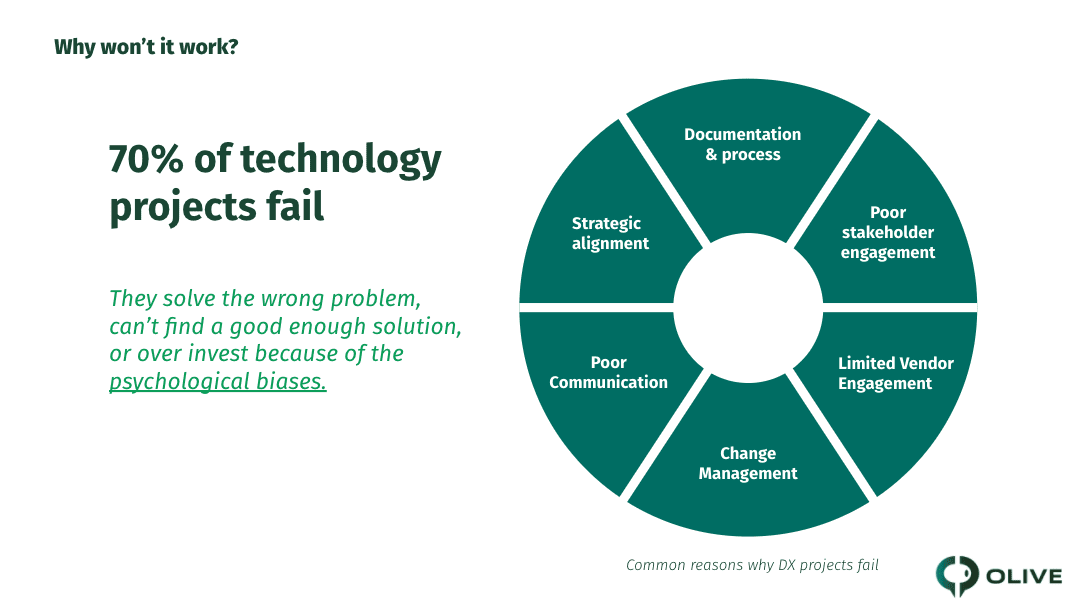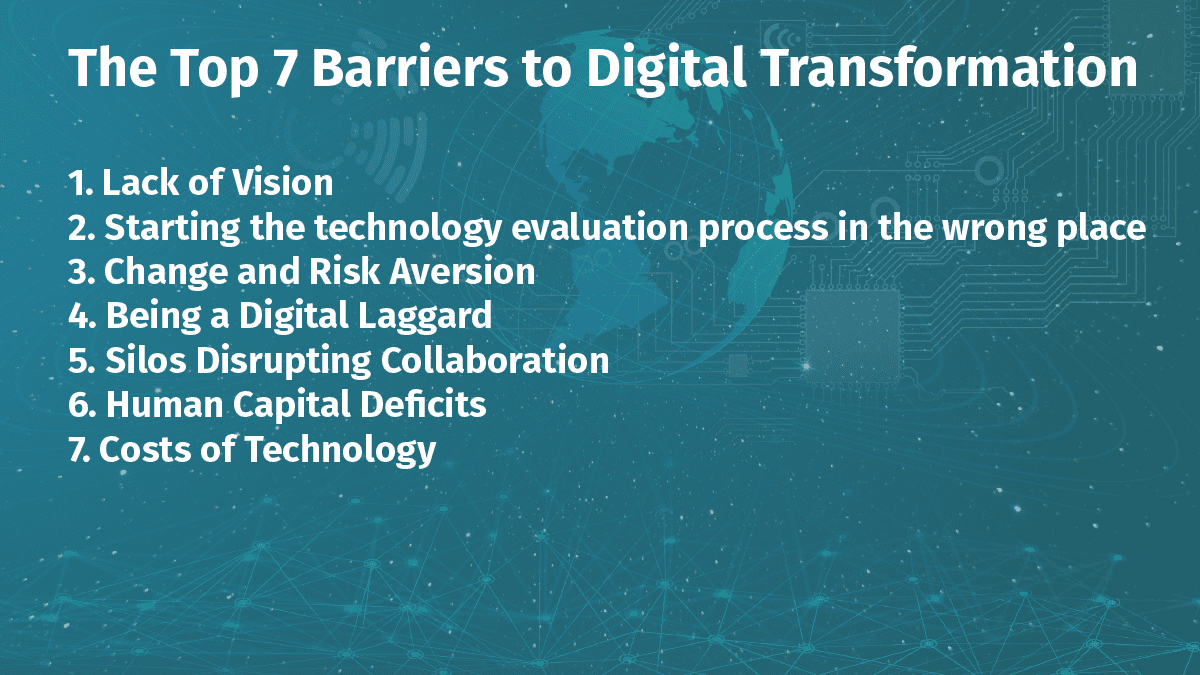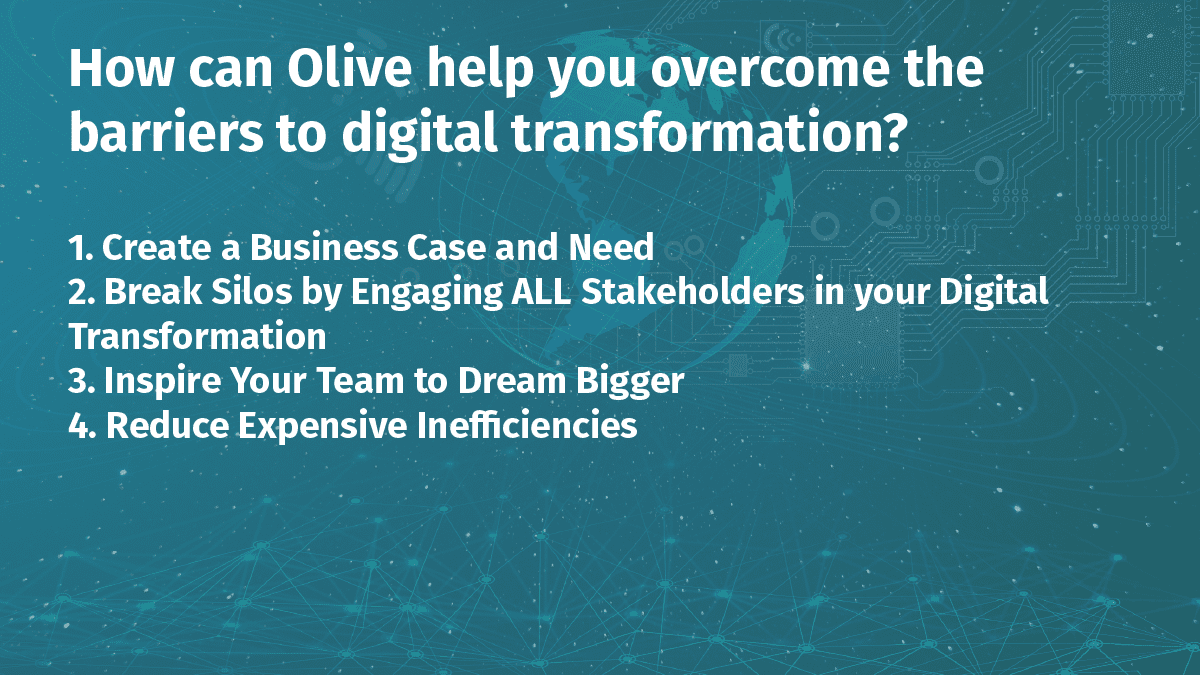What is Digital Transformation
Digital transformation is a culture and business change within your company.
It is a business change because it reimagines how your business operations can work. It introduces new technology into all areas of your organization in an attempt to accelerate processes, streamline and improve customer and employee experiences. Digital transformation can often reconfigure how you work but ultimately, it aims to deliver more profitable value to your business as a whole using technology.
Digital transformation is considered a company culture change because it is driven by the people and stakeholders of your organization. It relies on the leadership team for guidance, change management, budgeting, and more. It relies on line employees for developing the requirements, successful implementation, and adoption. Without a mindset shift and acceptance of the evolution of the business, digital transformations fail.
Why is the Digital Transformation Failure Rate So High?
Digital transformation is routinely pitched as an ‘adapt or die’ concept. While there is truth to that idea, it is rarely followed up with so much as a definition, let alone a roadmap of how to adapt successfully.
Despite digital transformation being critical, there is still an obnoxiously high failure rate of 70%. It is so difficult to get right because there is a disconnect in the process. You are told it is essential for remaining competitive and the very next step is to be sold to by tonnes of savvy new automated tools and bias-ridden market platforms like G2, Capterra and Gartner.

Nobody gives you the steps between or the tools to overcome the barriers. Nobody tells you how to navigate the software buying process efficiently. Nobody enforces vendor accountability because the power is not in your hands.
Let’s take a second to break down the barriers that lie in the way of successful digital transformation.

The Top 7 Barriers to Digital Transformation
Digital transformation looks different for every company and presents a host of risks. At Olive, we detail the exact barriers to successful digital transformation and, for good measure, we tell you how we carefully steer you past them.
1. Lack of Vision
Most businesses are overtly aware that digital transformation is the future. The problem is that this understanding isn’t nearly nuanced enough. Digital transformations mean different things to different companies and industries. Knowing what it means for you and what you are aiming to achieve is vital.
Considerations for your digital transformation vision
- What is your digital transformation trying to do?
- Are you trying to upgrade and protect your market share?
- Are you making a competitive move to expand?
- Are you open to a complete remodeling of current operations?
- What does success look like and why is it important?
Having a clear digital transformation vision prevents you from constantly being reactive to innovations from competitors and guides decisions for all stakeholders. If you are struggling, you may be falling into the digital laggard bracket and need a spark.
2. Starting the Technology Evaluation Process in the Wrong Place
CIOs and digital transformation leaders are under pressure to replace legacy software, processes, and systems from CEOs, competitors, and even suppliers. It often leads to haphazard decision-making.
You identify the technology that needs to be replaced. Then, you search the market looking for options. Finally, you present them to the team and make a decision. The next step is usually wondering why there is little to no up-take with the key stakeholders. Why? You didn’t solve the right problem.
3. Change and Risk Aversion
A fundamental component of digital transformation for CIOs to wrap their heads around is that risk is not experienced in the same way for all stakeholders.
Senior leaders see the financial risk and reputational risks. Management feels a potential incompetency risk. Line staff worry about redundancy and obsolescence risks. Change and risk aversion is a factor for 47% of stakeholders because they feel digital transformation threatens their current job or business security. Without a welcoming attitude and active change management strategies, implementation rarely goes smoothly.
4. Being a Digital Laggard
Digital leaders are companies who embrace their transformation. They allow new technologies to redefine how they do business and fundamentally change the structure of their enterprise. To them, it’s not just about new tools, it’s about people in the organization using technology to better their services and processes and deliver more value.
Digital laggards see DX as a support to what they already do. There is no room for widespread operations change because the mindset is limited to upgrading rather than disruption. This narrow view reduces the innovation opportunity and fails to prepare your business to fend off competitors with a reimagined, digitally transformed model.
Digital laggards limit the exceptional capacity of a DX to open new markets, reinvent your processes and discover value beyond simple efficiency upgrades.
5. Silos Disrupting Collaboration
Earlier this year, an intriguing book called CMO to CRO discussed how there are numerous teams responsible for revenue, marketing, IT, sales, yet they all have competing KPIs. The lack of collaboration undermines the actual business goal. The same occurs for digital transformation.
Stakeholders are not always heard equally. Sometimes, the right stakeholders are not heard at all. The time it takes to understand and appreciate all opinions is far too taxing for most CIOs. Assumptions are made and voices are discounted to shortcut the process. By allowing the silo’d nature of traditional business to limit the requirement gathering, you inevitably end up with software tools that don’t serve all purposes.
6. Human Capital Deficits
Pursuing digital transformation means going into uncharted territory for most members of staff. In many cases, line employees and leadership are not equipped with the skills to operate the new systems. Even your IT department may struggle to install new technologies without sufficient training.
Skills and competency gaps are often slow to come to the fore in digital transformation because people don’t broadcast weaknesses. In reality, it might require major upskilling, recruitment and even new leadership. Without addressing human resource requirements, and seeking strategic support where needed, digital transformations see low user adoption rates.
7. Costs of Technology
Digital transformation is riddled with different costs. Before you even purchase a piece of software, there is a time-consuming software selection process to go through. You must engage and elicit opinions from stakeholders all throughout the company, sift through and rank the requirements, speak to potential vendors and discuss options with senior leadership. Then there are training costs.
If you put it off because of these expenses, it gets worse. The competition takes an unassailable lead in your market. The cost of not budgeting appropriately leads to reputational damage among customers and even employees. Either way, cost, financial, human and time, is a major barrier in digital transformation and especially when it comes with such a high likelihood of failure.

How to Avoid Digital Transformation Failure
Olive is a digital transformation tool that actively addresses all barriers through our process.
1. Creating the Business Case and Need
The Olive digital transformation process begins by understanding your business and uncovering your pain points. We take a deep dive into why you feel the need for a digital transformation.
Starting with your business and needs helps to make the business case for why Digital Transformation is needed. It allows your leadership and line employees to understand the value and necessity to remain competitive. By understanding your needs, we help you to cultivate a guiding vision of what you want to achieve with digital transformation. This ensures that you start from the start and don’t miss critical details.
Once your vision is clearly articulated, we record it and make it visible to your stakeholders. This sets the context so that decisions and requirement suggestions align to your overall objectives.
2. Break Silos by Engaging ALL Stakeholders in your Digital Transformation
Consider your digital transformation vision as the runway. If this is where you want to land, your stakeholders are the pilots and flight attendants that get you there safely. They should all be heard and engaged throughout the process.
Olive makes it easy to collect their opinions and requirements efficiently. We issue surveys and record responses to make requirement gathering exceptionally smooth.
Engaging all stakeholders comes with a variety of crucial benefits. Firstly, it helps to unshackle the digital laggard tag by inviting input from various departments and creative mindsets. Often companies become digital laggards because input is confined to one or two leaders. Using Olive, your organization’s imagination is unlimited because we listen to everyone impacted. In addition, we find solutions you might not have thought of.
Beyond opening imaginations, our stakeholder engagement breaks down the silos between departments. We hear each person equally and allow the collective to steward decision making. Once requirements are gathered, we make it easy for stakeholders to collaborate and decide on the priorities. Our process not only expands the variety of input but it also values and respects all affected team members, which improves buy-in and ultimately drives user adoption.
3. Inspire Your Team to Dream Bigger
One of the lesser mentioned drawbacks to being a digital laggard is that staff rarely feel inspired. It often encourages them to look at innovative competitors and wish they had the opportunity to lead the industry and perform on more cutting edge projects.
Using the latest tools for digital transformation like Olive inspires and encourages the team to upskill and innovate to maintain relevance. If your organization is a digital leader, you organically nurture a culture of innovation by providing tools to be the best at what they do.
Your forward-thinking doesn’t just inspire your own team, it attracts talent. Excited by the innovation prospects, outside talent will be drawn to your business. This means a better applicant pool whenever new positions become available.
4. Reduce Expensive Inefficiencies
Expense is naturally a major deterrent to digital transformation. The process takes months of salaried hours and the capital outlay is often significant with no guarantee of success.
Olive’s agile collaborative platform gets you to a solution faster than ever. We elicit the opinions of your team in a fraction of the time at a fraction of the cost. We drastically reduce the failure risk because stakeholders are engaged throughout. With the increased stakeholder engagement , user adoption and implementation becomes a breeze as nobody is blindsided.
Getting Digital Transformation Right, with Olive
Digital transformation is inevitable for almost all industries. At Olive, we understand that it can be overwhelming but we provide expert guidance, easy-to-use surveys, libraries of requirements and perfectly matched, accountable vendor options. We provide the frameworks for you to make the digital transformation and become a more innovative enterprise. Olive breaks down the barriers and lets you imagine a better future with access to new markets thanks to a smooth digital transformation.




